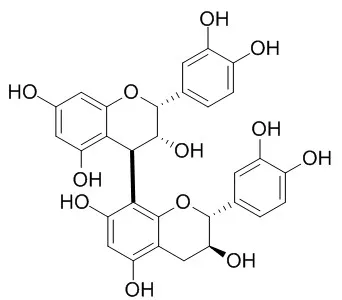| Description: |
Procyanidin B1, a HCV RNA polymerase inhibitor, inhibits infection by vesicular stomatitis virus and HCV pseudotype virus in Huh-7 cells, with IC50 of 29μM and 15μM, respectively. Procyanidin B1 has neuroprotective effects, may attenuate the activation of caspase-3 by inhibiting that of caspase-8 and -9. It has anti-inflammatory effect on LPS-treated THP1 cells via interaction with the TLR4–MD-2 heterodimer and p38 MAPK and NF-κB signaling. |
| In vitro: |
| J Ethnopharmacol. 2015 Jan 15;159:122-8. | | Protective effects of glycycoumarin and procyanidin B1, active components of traditional Japanese medicine yokukansan, on amyloid β oligomer-induced neuronal death.[Pubmed: 25446602] | Yokukansan, a traditional Japanese (Kampo) medicine, is composed of seven medicinal herbs, and has been traditionally used to treat neurosis, insomnia, and night crying and irritability in children. Yokukansan and its constituent herbs, Glycyrrhiza and Uncaria Hook, have recently been shown to have protective effects against amyloid β (Aβ) oligomer-induced apoptosis by suppressing the activation of caspase-3 in primary cultured neurons. The aim of the present study was to identify the effective components of Glycyrrhiza and Uncaria Hook against Aβ oligomer-induced neurotoxicity. We also attempted to clarify the mechanisms by which yokukansan and these herbs, as well as their components, suppressed the activation of caspase-3 in Aβ oligomer-treated neurons.
METHODS AND RESULTS:
Rat primary cultured cortical neurons were treated with Aβ oligomer (3 μM). The protective effects of 16 components derived from Glycyrrhiza or Uncaria Hook against Aβ oligomer-induced neurotoxicity were determined using the MTT reduction assay 48 h after the treatment. The suppressive effects of the test substances, i.e., yokukansan, Glycyrrhiza, Uncaria Hook, and screened components, on the Aβ oligomer-induced activation of caspase-3(/7) were evaluated using the caspase-Glo assay 48 h after the Aβ oligomer treatment. The suppressive effects of the test substances on the activation of caspase-8 and -9, both of which are located upstream of caspase-3, were also examined 24h after the Aβ oligomer treatment.
Two of the 16 components tested, glycycoumarin derived from Glycyrrhiza and Procyanidin B1 derived from Uncaria Hook, significantly inhibited Aβ oligomer-induced neuronal death in a dose-dependent manner. Glycyrrhiza, Uncaria Hook, and yokukansan significantly suppressed the Aβ oligomer-induced activation of caspase-3 as well as caspase-8 and -9. Glycycoumarin also suppressed the activation of caspase-3, but not caspase-8 and -9. Procyanidin B1 suppressed the activation of caspase-3, -8, and -9.
CONCLUSIONS:
Our results demonstrated that glycycoumarin and Procyanidin B1 had ameliorative effects on Aβ oligomer-induced neurotoxicity. The neuroprotective effects of glycycoumarin are thought to be due to the attenuated activation of caspase-3, but not caspase-8 or -9. Procyanidin B1, as well as yokukansan, Glycyrrhiza, and Uncaria Hook, may attenuate the activation of caspase-3 by inhibiting that of caspase-8 and -9. | | Antivir Chem Chemother. 2010 Aug 11;20(6):239-48. | | Procyanidin B1 purified from Cinnamomi cortex suppresses hepatitis C virus replication.[Pubmed: 20710064 ] | A combination of pegylated interferon and ribavirin is the current standard therapy for hepatitis C virus (HCV) infection, but this combination provides relatively low efficacy, especially in some patients with HCV genotype 1 infection; therefore, the development of novel therapeutic agents is required for further improvement in the treatment of chronic HCV infection.
METHODS AND RESULTS:
HCV pseudotype and subgenomic replicon assays were used in this study. The interaction of compounds with HCV receptors was examined using flow cytometry. Intracellular RNA levels were determined by semi-quantitative reverse transcriptase PCR.
Procyanidin B1 (PB1), a dimer of (-)-epicatechin and (+)-catechin, purified from Cinnamomi cortex, inhibits infection by vesicular stomatitis virus and HCV pseudotype virus in Huh-7 cells, with 50% effective concentrations of 29 and 15 microM, respectively. No inhibitory effects were observed in each component of PB1. We found that PB1 does not interfere with viral entry or receptor expression, but inhibits HCV RNA synthesis in a dose-dependent manner.
CONCLUSIONS:
These results indicate that PB1 suppresses HCV RNA synthesis, possibly as a HCV RNA polymerase inhibitor. Our results might contribute towards the development of more effective inhibitors for HCV infection from natural plants. |
|
| In vivo: |
| Eur J Pharmacol. 2012 Feb 29;677(1-3):147-53. | | Flavangenol (pine bark extract) and its major component procyanidin B1 enhance fatty acid oxidation in fat-loaded models.[Pubmed: 22227333] | Flavangenol, one of several pine bark extract products, is expected to prevent metabolic diseases with its potent antioxidant effect, its anti-obesity effect and its improvement of insulin sensitivity.
METHODS AND RESULTS:
In this study, targeting the liver as one of the organs that plays an important role in energy metabolism, Flavangenol was investigated for its effect on non-alcoholic fatty liver disease (NAFLD), its action mechanism and its active ingredients, using in vivo and in vitro experiment systems. Flavangenol suppressed intrahepatic fat accumulation in Western diet-loaded Tsumura Suzuki Obese Diabetes (TSOD) mice, which develop various metabolic diseases. In addition, Flavangenol significantly increased the mRNA expression levels of fatty acid oxidative enzymes (peroxisomal proliferator-activated receptor α, acyl-CoA oxidase, carnitine palmitoyltransferase). In order to investigate the direct effect of Flavangenol on the liver, an in vitro fatty liver model prepared by adding a free fatty acid to human liver cancer cells (HepG2 cells) was used. In this model, Flavangenol significantly suppressed intracellular fat accumulation. Procyanidin B1, one of the major components of Flavangenol, also suppressed fat accumulation and induced mRNA expression of the fatty acid oxidative enzymes.
CONCLUSIONS:
As mentioned above, Flavangenol showed a significant suppressive effect in the NAFLD model, and it was suggested that the molecular mechanism is induction of fatty acid oxidation, with the effect mainly attributed to Procyanidin B1. |
|






 Cell. 2018 Jan 11;172(1-2):249-261.e12. doi: 10.1016/j.cell.2017.12.019.IF=36.216(2019)
Cell. 2018 Jan 11;172(1-2):249-261.e12. doi: 10.1016/j.cell.2017.12.019.IF=36.216(2019) Cell Metab. 2020 Mar 3;31(3):534-548.e5. doi: 10.1016/j.cmet.2020.01.002.IF=22.415(2019)
Cell Metab. 2020 Mar 3;31(3):534-548.e5. doi: 10.1016/j.cmet.2020.01.002.IF=22.415(2019) Mol Cell. 2017 Nov 16;68(4):673-685.e6. doi: 10.1016/j.molcel.2017.10.022.IF=14.548(2019)
Mol Cell. 2017 Nov 16;68(4):673-685.e6. doi: 10.1016/j.molcel.2017.10.022.IF=14.548(2019)